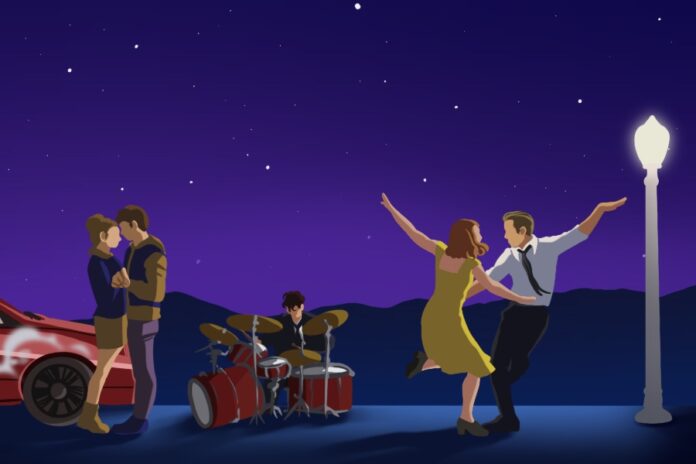Music, movies — why choose?
Music has long been the Robin to many a feature film’s Batman. Standing in as an emotional primer and catalyst for movies, music draws sadness, builds suspense and emphasizes triumph. The most memorable of our favorite scenes are often accompanied by iconic film scorers including John Williams of “Star Wars” and Ennio Morricone of “The Good, The Bad, and the Ugly.”
Recently, in certain feature films, the roles of music and movies have become enmeshed, harnessing music to drive the plot. If you are interested in jump-starting a foray into musically driven films, the films below are an excellent start. They exhibit an array of musical and cinematic expertise, in broad ranging genres from romance to thrillers.
One director whose meteoric rise has fueled a newfound interest in this genre of music-driven movies is Damien Chazelle, a French-American former music student turned movie director. One of his more well-known works is “La La Land,” the 2016 musical drama featuring the enchanting couple of Ryan Gosling and Emma Stone. “La La Land” tethers its plotline to the musicality and musical aspirations of its core protagonists. Although it’s a musical, it doesn’t exude the abruptness of its musical numbers, blending them subtly within the structure of the plot. The entire movie is motivated and driven by Chazelle’s unadulterated love for music. The melodic and soothing rhythms of jazz undergird the production, making subtle references to famous artists and to the genre’s decline from popularity in recent days.
Chazelle’s breakout 2014 film “Whiplash” is an ode to the raw power of jazz and the fastidious work ethic that fuels it. The film starkly contrasts “La La Land,” focusing on some of the socially eroding consequences of obsession. Inspired by his own life as a musician, Chazelle channels the energy of jazz and its immersive impact on the main character Andrew Niemann’s disposition and relationships.
Like a drummer to a band, Justin Hurwitz’s scores are the heartbeat to both the film scores. In “La La Land” he guides the movie with heart-fluttering tunes like “Planetarium” to play off the dreamy themes of the film, while in Whiplash he cultivates the score with adrenaline-pumping and sweat-inducing songs like “Caravan” that constantly keep the audience on the edge of their seats. Rather than using the scores as a supplement, they become the film’s backbone, as pivotal to the plotline and creative direction as the acting.
Another example of a recent movie featuring music that may be slightly more underplayed but just as vital to the movie is “Baby Driver.” Directed by Edgar Wright, “Baby Driver” follows the life of Baby — a quirky, baby-faced getaway driver — and his attempt to break free from a life of crime. In order to offset tinnitus in his ears, Baby goes everywhere with headphones glued in his ears.
Using songs like “Brighton Rock” by Queen and “Easy” by the Commodores, Baby’s playlists function as the film’s engine. A prescient clip from the film occurs during the second car chase scene. Right as the heist is about to begin, Baby has to start the song “Neat, Neat, Neat” by The Damned over to sync the actions to his soundtrack. This brief action plays on two different dimensions. It demonstrates that music is bound to Baby’s mindset and subtly breaks the fourth wall when Baby restarts the song to sync perfectly to the upcoming action. In “Baby Driver” scenes, film and music become harmonious, neither one overpowering the other. To a certain degree, Wright’s scenes mirror highly contextualized, visceral music videos.
Being a lover of both music and movies, I view this form of film as a perfect creative storm. The style has become an evolutionized cousin of the musical, holding music front and center, while transforming the film’s layout to fit with broader modern palettes. With talented directors like Damien Chazelle leading the charge, it will be fascinating to track the progression and evolution of these music-centric films.
Written By: Andrew Williams — arts@theaggie.org





Jazz is admittedly an uneasy vehicle for the ideas that the film wants to play with and poke around. Seb s obsession is helpful in removing him from Mia s world, but it ultimately does more to distract from the Hollywood setting than it does to flesh it out. But I doubt that Chazelle ever had much of a choice in the matter. Had the director grown up to be an obsessive fan of practical special effects, for example, perhaps Seb could have worshipped Ray Harryhausen s paintbrush instead of Hoagie Carmichael s stool. But that s not who Chazelle is, that s not what he cares about, and if he